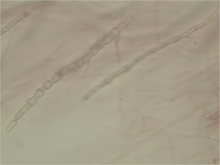Fusarium
Fusarium /fjuˈzɛəriəm/(help·info) is a large genus of filamentousfungi, part of a group often referred to as hyphomycetes, widely distributed in soil and associated with plants. Most species are harmless saprobes, and are relatively abundant members of the soil microbial community. Some species produce mycotoxins in cereal crops that can affect human and animal health if they enter the food chain. The main toxins produced by these Fusarium species are fumonisins and trichothecenes![]() . Despite most species apparently being harmless (some existing on the skin as commensal members of the skin flora), some Fusarium species and subspecific groups are among the most important fungal pathogens of plants and animals.
. Despite most species apparently being harmless (some existing on the skin as commensal members of the skin flora), some Fusarium species and subspecific groups are among the most important fungal pathogens of plants and animals.
The taxonomy of the genus is complex. A number of different schemes have been used, and up to 1,000 species have been identified at times, with approaches varying between wide and narrow concepts of speciation (lumpers and splitters).[2][3][4]
There is a proposed concept – widely subscribed by specialists – that would include essentially the genus as it now stands, including especially all agriculturally significant Fusaria.[5][6] There is a counterproposal (unrelated to Watanabe 2011) that goes far in the other direction, with seven entirely new genera.[7]
Various schemes have subdivided the genus into subgenera and sections. There is a poor correlation between sections and phylogenetic clades.[4]
Fusarium graminearum commonly infects barley if there is rain late in the season. It is of economic impact to the malting and brewing industries, as well as feed barley. Fusarium contamination in barley can result in head blight, and in extreme contaminations, the barley can appear pink.[8] The genome of this wheat and maize pathogen has been sequenced. F. graminearum can also cause root rot and seedling blight. The total losses in the US of barley and wheat crops between 1991 and 1996 have been estimated at $3 billion.[8]
Fusarium oxysporum f.sp. cubense is a fungal plant pathogen that causes Panama disease of banana (Musa spp.), also known as fusarium wilt of banana. Panama disease affects a wide range of banana cultivars, which are propagated asexually from offshoots and therefore have very little genetic diversity. Panama disease is one of the most destructive plant diseases of modern times, and caused the commercial disappearance of the once dominant Gros Michel cultivar. A more recent strain also affects the Cavendishcultivars which commercially replaced Gros Michel. It is considered inevitable that this susceptibility will spread globally and commercially wipe out the Cavendish cultivar, for which there are currently no acceptable replacements.

